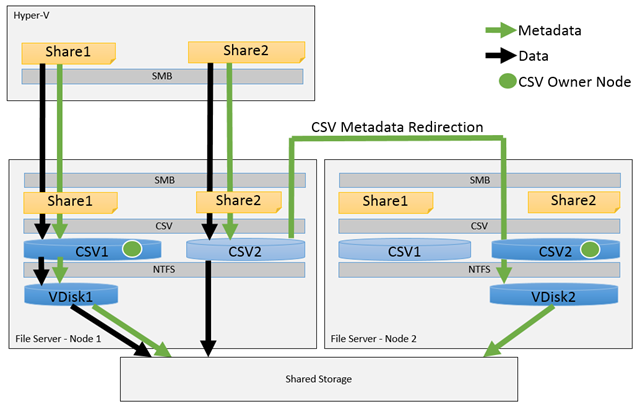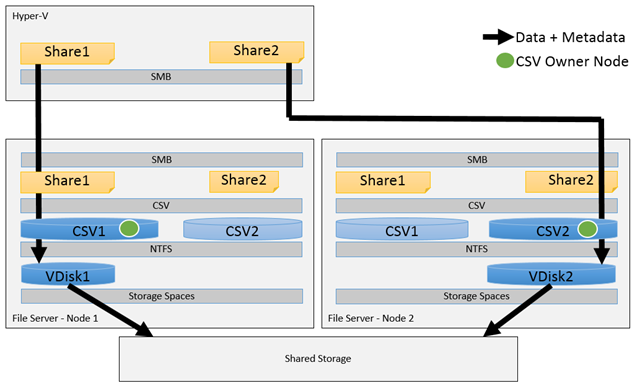Automatic SMB Scale-Out Rebalancing in Windows Server 2012 R2
Introduction
This blog post focus on the new SMB Scale-Out Rebalancing introduced in Windows Server 2012 R2. If you haven’t seen it yet, it delivers a new way of balancing file clients accessing a Scale-Out File Server.
In Windows Server 2012, each client would be randomly directed via DNS Round Robin to a node of the cluster and stick with that one for all shares, all traffic going to that Scale-Out File Server. If necessary, some server-side redirection of individual IO requests could happen in order to fulfill the client request.
In Windows Server 2012 R2, a single client might be directed to a different node for each file share. The idea here is that the client will connect to the best node for each individual file share in the Scale-Out File Server Cluster, avoiding any kind of server-side redirection.
Now there are some details about when redirection can happen and when the new behavior will apply. Let’s look into the 3 types of scenarios you might encounter.
Hyper-V over SMB with Windows Server 2012 and a SAN back-end (symmetric)
When we first introduced the SMB Scale-Out File Server in Windows Server 2012, as mentioned in the introduction, the client would be randomly directed to one and only one node for all shares in that cluster.
If the storage is equally accessible from every node (what we call symmetric cluster storage), then you can do reads and writes from every file server cluster node, even if it’s not the owner node for that Cluster Shared Volume (CSV). We refer to this as Direct IO.
However, metadata operations (like creating a new file, renaming a file or locking byte range on a file) must be done orchestrated cross the cluster and will be executed on a single node called the coordinator node or the owner node. Any other node will simply redirect these metadata operations to the coordinator node.
The diagram below illustrates these behaviors:
Figure 1: Windows Server 2012 Scale-Out File Server on symmetric storage
The most common example of symmetric storage is when the Scale-Out File Server is put in front of a SAN. The common setup is to have every file server node connected to the SAN.
Another common example is when the Scale-Out File Server is using a clustered Storage Spaces solution with a shared SAS JBOD using Simple Spaces (no resiliency).
Hyper-V over SMB with Windows Server 2012 and Mirrored Storage Spaces (asymmetric)
When using a Mirrored Storage Spaces, the CSV operates in a block level redirected IO mode. This means that every read and write to the volume must be performed through the coordinator node of that CSV.
This configuration, where not every node has the ability to read/write to the storage, is generically called asymmetric storage. In those cases, every data and metadata request must be redirected to the coordinator node.
In Windows Server 2012, the SMB client chooses one of the nodes of the Scale-Out File Server cluster using DNS Round Robin and that may not necessarily be the coordinator node that owns the CSV that contains the file share it wants to access.
In fact, if using multiple file shares in a well-balanced cluster, it’s likely that the node will own some but not all of the CSVs required.
That means some SMB requests (for data or metadata) are handled by the node and some are redirected via the cluster back-end network to the right owner node. This redirection, commonly referred to as “double-hop”, is a very common occurrence in Windows Server 2012 when using the Scale-Out File Server combined with Mirrored Storage Spaces.
It’s important to mention that this cluster-side redirection is something that is implemented by CSV and it can be very efficient, especially if your cluster network uses RDMA-capable interfaces.
The diagram below illustrates these behaviors:
Figure 2: Windows Server 2012 Scale-Out File Server on asymmetric storage
The most common example of asymmetric storage is when the Scale-Out File Server is using a Clustered Storage Spaces solution with a Shared SAS JBOD using Mirrored Spaces.
Another common example is when only a subset of the file server nodes is directly connected to a portion backend storage, be it Storage Spaces or a SAN.
A possible asymmetric setup would be a 4-node cluster where 2 nodes are connected to one SAN and the other 2 nodes are connected to a different SAN.
Hyper-V over SMB with Windows Server 2012 R2 and Mirrored Storage Spaces (asymmetric)
If you’re following my train of thought here, you probably noticed that the previous configuration has a potential for further optimization and that’s exactly what we did in Windows Server 2012 R2.
In this new release, the SMB client gained the flexibility to connect to different Scale-Out File Server cluster nodes for each independent share that it needs to access.
The SMB server also gained the ability to tell its clients (using the existing Witness protocol) what is the ideal node to access the storage, in case it happens to be asymmetric.
With the combination of these two behavior changes, a Windows Server 2012 R2 SMB client and server are capable to optimize the traffic, so that no redirection is required even for asymmetric configurations.
The diagram below illustrates these behaviors:
Figure 3: Windows Server 2012 R2 Scale-Out File Server on asymmetric storage
Note that the SMB client now always talks to the Scale-Out File Server node that is the coordinator of the CSV where the share is.
Note also that the CSV ownership is shared across nodes in the example. That is not a coincidence. CSV now includes the ability to spread its CSVs across the nodes uniformly.
If you add or remove nodes or CSVs in the Scale-Out File Server cluster, the CSVs will be rebalanced. The SMB clients will then also be rebalanced to follow the CSV owner nodes for their shares.
Key configuration requirements for asymmetric storage in Windows Server 2012 R2
Because of this new automatic rebalancing, there are key new considerations when designing asymmetric (Mirrored or Parity Storage Spaces) storage when using Windows Server 2012 R2.
First of all, you should have at least as many CSVs as you have file server cluster nodes. For instance, for a 3-node Scale-Out File Server, you should have at least 3 CSVs. Having 6 CSVs is also a valid configuration, which will help with rebalancing when one of the nodes is down for maintenance.
To be clear, if you have a single CSV in such asymmetric configuration in Windows Server 2012 R2 Scale-Out File Server cluster, only one node will be actively accessed by SMB clients.
You should also try, as much as possible, to have your file shares and workloads evenly spread across the multiple CSVs. This way you won’t have some nodes working much harder than others.
Forcing per-share redirection for symmetric storage in Windows Server 2012 R2
The new per-share redirection does not happen by default in the Scale-Out File Server if the back-end storage is found to be symmetric.
For instance, if every node of your file server is connected to a SAN back-end, you will continue to have the behavior described on Figure 1 (Direct IO from every node plus metadata redirection).
The CSVs will automatically be balanced across file server cluster nodes even in symmetric storage configurations. You can turn that behavior off using the cmdlet below, although I'm hard pressed to find any good reason to do it.
(Get-Cluster). CSVBalancer = 0
However, when using symmetric storage, the SMB clients will continue to each connect a single file server cluster node for all shares. We opted for this behavior by default because Direct IO tends to be efficient in these configurations and the amount of metadata redirection should be fairly small.
You can override this setting and make the symmetric cluster use the same rebalancing behavior as an asymmetric cluster by using the following PowerShell cmdlet:
Set-ItemProperty HKLM:\System\CurrentControlSet\Services\LanmanServer\Parameters -Name AsymmetryMode -Type DWord -Value 2 -Force
You must apply the setting above to every file server cluster node. The new behavior won’t apply to existing client sessions.
If you switch to this configuration, you must apply the same planning rules outlined previously (at least one CSV per file server node, ideally two).
Conclusion
I hope this clarifies the behavior changes introduced with SMB Scale-Out Automatic Rebalancing in Windows Server 2012 R2.
While most of it is designed to just work, I do get some questions about it from those interested in understanding what happens behind the scenes.
Let me know if you find those useful or if you have any additional questions.


